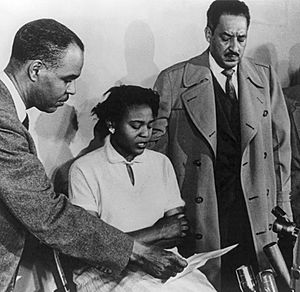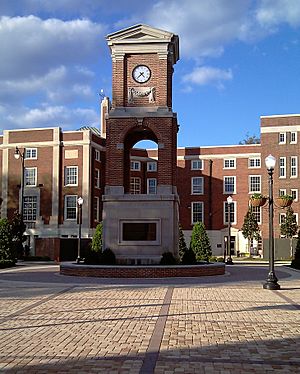Autherine Lucy facts for kids
Quick facts for kids
Autherine Lucy
|
|
|---|---|

Lucy in 1955
|
|
| Born |
Autherine Juanita Lucy
October 5, 1929 Shiloh, Alabama, U.S.
|
| Died | March 2, 2022 (aged 92) |
| Education | |
| Occupation | Educator, professor |
| Years active | 1956–2022 |
| Known for | First African-American student to attend the University of Alabama, 1956 |
| Relatives | Nikema Williams (grandniece) |
Autherine Juanita Lucy (born October 5, 1929 – died March 2, 2022) was an American activist. She became the first African-American student to attend the University of Alabama in 1956. She was later removed from the university, which led to the school's president, Oliver Carmichael, leaving his job. Years later, the University of Alabama welcomed her back as a student. In 2010, a clock tower was built on campus to honor her.
Contents
Early Life and Education
Autherine Lucy was born in Shiloh, Alabama. Her parents, Milton Cornelius Lucy and Minnie Maud Hosea, were sharecroppers. This meant they farmed land owned by someone else and shared the crops they grew. Autherine was the youngest of nine children.
Her family owned and farmed 110 acres of land. Her father also worked as a blacksmith and made things like baskets to earn extra money. Autherine went to public school in Shiloh. After that, she attended Linden Academy and graduated in 1947. She then studied at Selma University for two years. Later, she went to Miles College, a college mainly for Black students, and earned a degree in English in 1952.
Fighting for Equal Education
In September 1952, Autherine Lucy and her friend, Pollie Myers, applied to the University of Alabama. Pollie was a civil rights activist with the NAACP. Autherine said she wanted to get another college degree, not for political reasons, but to get the best education in Alabama.
Even though they were accepted at first, the university changed its mind when they found out Autherine and Pollie were Black. With help from the NAACP, Autherine and Pollie took the university to court. They said the university was unfairly treating them because of their race. This court case took almost three years. While waiting, Autherine worked as an English teacher and a secretary.
On June 29, 1955, the NAACP won a court order. This order stopped the University of Alabama from rejecting Autherine and Pollie (who was now known as Pollie Myers Hudson) because of their race. Autherine was finally allowed to enroll. However, the university still would not let her live in the dorms or eat in the dining halls.
On February 3, 1956, Autherine Lucy became a graduate student in library science. She was the first African American ever admitted to a public white school or university in Alabama.
Facing Challenges at the University
Autherine attended her first class on Friday, February 3, 1956. On Monday, February 6, 1956, big protests happened on campus. A large crowd of over a thousand people threw things at the car that was driving Autherine between classes. People threatened her life, and the university president's house was attacked. Police had to be called to protect her.
These protests were the most violent anti-integration demonstrations after the 1954 Brown v. Board of Education Supreme Court decision. That decision said that separating students by race in public schools was illegal. After the protests, the university suspended Autherine. They said it was for her own safety.
Autherine Lucy is known for helping to end segregation in Alabama's schools. Thurgood Marshall, who later became the first African-American Supreme Court Justice, helped her. He and other lawyers for Autherine and the NAACP sued the university. They believed the school did not protect her and stopped her from attending classes.
Even though Autherine felt defeated after being removed from school, Thurgood Marshall encouraged her. He wrote to her, saying, "Whatever happens in the future, remember... that your contribution has been made toward equal justice for all Americans."
Autherine and the NAACP tried to take the university to court again. They said the university did not follow the court's orders to protect her. On February 29, the Federal Court in Birmingham ordered that Autherine be allowed back. It also said the university must protect her. However, the university then permanently removed her. They claimed Autherine had said bad things about the university. The NAACP decided not to fight this decision further.
The university president, Oliver Carmichael, resigned because he disagreed with the university's leaders about letting Autherine in. In April 1956, Autherine married Hugh Foster, a divinity student. For a few months, she spoke at NAACP meetings. But by the end of that year, she stopped being actively involved in the Civil Rights Movement.
Later Life and Legacy
After Autherine was removed from the university, Thurgood Marshall was worried about her safety. He brought her to New York to stay with him and his wife. Autherine later said she felt very safe and grateful for their kindness.
For the next 17 years, Autherine and her family lived in different cities. It was hard for her to find a job as a teacher at first because of her fame. In 1974, the Fosters moved back to Alabama. Autherine then got a job in the Birmingham school system.
In April 1988, the University of Alabama officially canceled her earlier removal. The next year, she enrolled in a graduate program in Education. She earned her Master's degree in May 1992. The university also created a special scholarship in her honor. They put up a portrait of her in the student union building. The words on it say that her bravery helped students of all races attend the university.
Autherine Lucy passed away on March 2, 2022, at the age of 92. Her grandniece, Nikema Williams, is a member of the United States House of Representatives.
Honoring Her Contributions
On November 3, 2010, the Autherine Lucy Clock Tower was dedicated. It is part of a new area called the Malone-Hood Plaza. This plaza honors Autherine Lucy, Vivian Malone, and James Hood. These three people were pioneers in ending segregation at the University of Alabama. The plaza is next to Foster Auditorium. In 1963, Alabama Governor George Wallace tried to stop Malone and Hood from enrolling there.
The 40-foot-tall brick tower has bronze plaques at its base. These plaques tell the stories of Autherine, Vivian, and James. Also, on September 15, 2017, a special marker was placed near Graves Hall on the university campus to honor her. Autherine Lucy spoke at the ceremony. She compared the welcoming crowd to the hatred she faced when she first entered the university.
In May 2019, Autherine Lucy attended the University of Alabama's graduation ceremony. The school gave her an honorary doctorate degree.
Autherine's legacy continues at the University of Alabama. There is a $25,000 scholarship named after her. In 1992, a picture of Autherine was put up at the university. On February 3, 2022, the university added Autherine's name to what was formerly Bibb Graves Hall, renaming it Lucy-Graves Hall. After many students and faculty spoke out, the university completely removed Graves's name on February 11, 2022. The building is now called Autherine Lucy Hall.
See also
 In Spanish: Autherine Lucy para niños
In Spanish: Autherine Lucy para niños



